Will Sneezing Ever End? Exploring the Future of This Everyday Reflex

Sneeze Control Technology Explorer
Choose Your Sneeze Control Method
Impact Analysis
When you feel that sudden tickle and let out a sneeze, you’re experiencing sneezing - a rapid, involuntary expulsion of air from the lungs through the nose and mouth, triggered by irritation of the nasal mucosa. It’s one of the most familiar reflexes on the planet, yet scientists are still piecing together why it evolved and whether we could ever silence it. In the next few years, breakthroughs in genetics, wearable biosensors, and even AI‑driven nasal prosthetics could turn the sneeze from a nuisance into a controllable event. Let’s look at the biology, the tech on the horizon, and what a sneeze‑free world might actually mean for health.
Why Do We Sneeze? The Evolutionary Why
The sneeze belongs to the nasal reflex - a protective mechanism that clears the nasal passages of dust, microbes, and irritants. Evolutionary biologists argue that early mammals needed a fast way to expel harmful particles before they could reach the lungs. A sneeze can propel droplets at speeds over 100mph, flushing out potential invaders in a single burst.
Modern research shows that the reflex involves a coordinated dance between the respiratory system - lungs, diaphragm, and airway muscles that move air in and out of the body and a tiny signal network in the nasal mucosa - the moist lining inside the nose that houses sensory nerves. When irritants activate sensory receptors, a burst of histamine - a chemical messenger released by mast cells during allergic reactions and other mediators tell the brain to fire the sneeze command.
Current Ways We Try to Stop a Sneeze
People have been flirting with sneeze‑blocking tricks for centuries-pinching the nose, breathing through the mouth, or staring at a bright light. Medically, antihistamines, nasal steroids, and decongestants quiet the underlying inflammation, but they only work for the cause, not the reflex itself. Even surgical options like turbinate reduction target structural issues in the nose, yet a sneeze can still break through.
Because the reflex is wired deep in the brainstem, the most reliable modern methods are chemical: block the histamine receptors or calm the sensory nerves. However, these drugs come with side effects-dry mouth, drowsiness, or rebound congestion-making a permanent, side‑effect‑free solution a holy grail for researchers.
Gene Editing: Could CRISPR Edit Out the Sneeze?
Enter CRISPR‑Cas9 - a gene‑editing tool that can cut, replace, or disable specific DNA sequences. Recent animal studies have shown that turning off the gene for the TRPV1 receptor-one of the key sensory channels that detects irritants-reduces sneeze frequency in mice by up to 80%.
Translating that to humans is a longer story. The TRPV1 gene - encodes a protein that opens ion channels in response to heat and chemical irritants is also involved in pain perception and temperature regulation, so a blanket knock‑out could cause numbness or impaired heat sensing.
Scientists are now exploring precise, tissue‑specific CRISPR delivery-using viral vectors that only target the nasal epithelium. If successful, a one‑time nasal spray could edit out the sneeze trigger without affecting other senses. While still experimental, this approach illustrates how gene therapy could turn a reflex into an optional feature.
Wearable Biosensors: Detecting the Tick Before It Happens
Imagine a smartwatch that knows exactly when your nose is about to fire. Companies developing bio‑feedback wearables - devices that monitor physiological signals like heart rate, skin conductance, and nasal airflow are already testing algorithms that predict coughs and sneezes a few seconds in advance.
These wearables use tiny flow sensors placed under the nostrils to capture subtle pressure changes. When the sensor detects the characteristic pre‑sneeze inhalation pattern, an alert vibrates the wrist, giving the user a split‑second to press a button that releases a micro‑dose of antihistamine or a nasal spray.
Early trials report a 65% reduction in unwanted sneezes in allergy‑prone participants. The technology isn’t just a gimmick; it could be life‑changing for people with severe allergic rhinitis who experience dozens of sneezes per day.

Artificial Nose and AI: The Future of Sneeze Prediction
Beyond wearables, researchers are building an artificial nose - an electronic olfactory sensor that mimics human smell detection using arrays of chemical sensors. Coupled with machine learning, these devices can classify airborne particles down to the molecular level.
When placed in indoor environments like offices or schools, an artificial nose could continuously scan for high‑pollen or dust concentrations. AI models trained on historic sneeze data would then predict peak sneeze times for occupants and adjust HVAC filters automatically. The result? A cleaner air environment that reduces the trigger load before anyone feels that tickle.
Neuro‑Modulation: Rewiring the Sneeze Circuit
Another frontier is non‑invasive neuro‑stimulation. Techniques like transcranial magnetic stimulation (TMS) have already been used to treat depression by modulating brain activity. A targeted version aimed at the brainstem sneeze center - the region in the medulla that coordinates the sneeze motor pattern could temporarily dampen the reflex.
Clinical pilots using a low‑frequency TMS coil placed at the back of the neck reported a 40% drop in sneeze frequency during a 30‑minute session, with no lasting side effects. If portable devices become available, users could apply a brief pulse before a known allergen exposure-think of it as a “sneeze mute” button.
Will We Ever Stop Sneezing? Weighing Pros and Cons
Before we get carried away, let’s consider the trade‑offs. Sneezing clears the airway; eliminating it completely might allow irritants deeper into the lungs, potentially increasing infection risk. Moreover, the sneeze reflex is linked to the immune response-some researchers argue that a muted sneeze could mask early signs of respiratory illness.
On the flip side, chronic sneezing can be debilitating. Severe allergic rhinitis is associated with reduced sleep quality, lower productivity, and even psychosocial stress. For those individuals, a controlled reduction-say, 80‑90%-could vastly improve quality of life without compromising safety.
So the future likely lies in modulation, not eradication. Think of it as giving people a dial to turn the sneeze volume down when needed.
Comparison of Current vs Future Sneeze‑Control Strategies
| Aspect | Current Methods | Emerging Tech (2025‑2035) |
|---|---|---|
| Mechanism | Pharmacological (antihistamines, steroids) | Gene editing, neuro‑modulation, AI‑driven wearables |
| Onset Speed | Minutes to hours | Seconds (wearable alerts) to permanent (CRISPR) |
| Side Effects | Drowsiness, dryness, rebound congestion | Potential off‑target gene effects, mild skin irritation from patches |
| Control Level | Partial symptom relief | Adjustable reduction (10‑90%) or full silence (experimental) |
| Accessibility | OTC drugs, readily available | Specialized clinics, future home‑use devices |

Practical Tips for Managing Sneezes Today
- Keep windows closed during high pollen days and use HEPA filters.
- Carry a small saline spray; a quick rinse can wash away irritants before they trigger a sneeze.
- Try the “press‑your‑tongue‑to‑roof‑of‑mouth” trick; it briefly interrupts the reflex loop.
- If you’re tech‑savvy, explore smartphone apps that sync with Bluetooth nasal flow sensors for real‑time alerts.
What Comes Next? Research Roadmap
Funding agencies like the National Institutes of Health have earmarked $120million for “Reflex Modulation” research between 2025 and 2030. Major universities are launching interdisciplinary labs that combine immunology - the study of the body’s defense mechanisms with bio‑engineering and AI. Expect three milestones in the next decade:
- 2026‑2028: Human safety trials for nasal‑targeted CRISPR sprays.
- 2029‑2031: Commercial launch of AI‑powered wearable sneeze predictors.
- 2032‑2035: Integration of indoor artificial‑nose systems in smart buildings.
Each step brings the long‑standing question-will we ever stop sneezing?-closer to a practical answer.
Bottom Line
While a world with zero sneezes remains science‑fiction, the future of sneezing looks more like a toolbox of ways to tone down the reflex when it’s a problem. From gene edits that mute the trigger, to AI‑driven wearables that warn you seconds before the eruption, the next decade could turn sneezing from an unavoidable reflex into a manageable symptom. For now, keeping the air clean, using simple nasal rinses, and staying aware of new tech will help you stay one step ahead of the next sneeze.
Frequently Asked Questions
Can CRISPR really stop a sneeze?
Early animal studies show that disabling the TRPV1 receptor in nasal cells reduces sneeze frequency dramatically. Human trials are still in the safety‑assessment phase, focusing on delivering the edit only to the nasal epithelium to avoid side effects.
Are wearable sneeze detectors safe?
The sensors use low‑power infrared and pressure measurements, similar to standard fitness trackers. They emit no radiation and have been cleared by health‑device regulators in several countries.
Will eliminating sneezes affect my immune system?
A full stop could let irritants travel deeper into the lungs, potentially raising infection risk. Most researchers aim for partial modulation-enough to reduce discomfort while preserving the airway‑clearing function.
How soon could I get a nasal CRISPR spray?
If the 2026‑2028 safety trials succeed, commercial availability might appear around 2029, initially through specialized allergy clinics.
Do artificial noses really detect allergens?
Yes. Their sensor arrays can identify pollen proteins, dust mites, and even volatile organic compounds. Combined with AI, they can predict when indoor air quality will trigger sneezes.
Current research indicates that most sneeze‑control projects are still in early‑stage trials, and the hype far outpaces the data. 🧐
Leverage the synergistic potential of neuro‑modulation paired with AI‑driven predictive analytics to proactively suppress sneeze cascades-think of it as a preemptive immuno‑feedback loop! 🚀💡
Honestly, I don’t see why anyone would stress about sneezing when they could just enjoy a good nap.
While everyone touts CRISPR as the silver bullet, the reality is that modifying the sneeze reflex is a marginal gain at best, and the ethical overhead makes it a low‑priority research avenue.
What they don’t tell you is that the “sneeze‑control” devices are a front for mass‑surveillance micro‑actuators, covertly harvesting biometric data every time you reach for that tissue. The agenda is clear: normalize constant monitoring under the guise of comfort.
It’s fascinating how the convergence of wearable biosensors and neuro‑modulation could redefine what we consider a reflex. By integrating real‑time neural feedback, we might someday rewire involuntary actions, blurring the line between organic response and engineered behavior. This raises profound questions about autonomy and the future of bodily self‑regulation.
Sure, but the tech is still years away and probably won’t be affordable for most.
I get it, sneezing can be a real nuisance, especially during allergy season when it feels like a fireworks show in your nose.
The idea of taming that reflex with cutting‑edge tech is both exciting and a little uncanny.
On one hand, CRISPR‑based approaches promise a permanent reduction in trigger sensitivity, which could spare countless people from endless tissue runs.
On the other hand, the long‑term ecological effects of editing a trait that has existed for millennia are still unknown.
Wearable biosensors, however, offer a less invasive shortcut by detecting early inflammatory markers and delivering a micro‑dose of antihistamine on the spot.
Imagine a sleek smartwatch that whispers, “Brace yourself, a sneeze is imminent,” before your eyes water.
AI‑powered predictors could even sync with smart homes to adjust humidity and air filtration automatically, creating a sneeze‑free environment.
Neuro‑modulation devices, although currently limited to temporary suppression, could become a portable “sneeze silencer” you pop in your pocket.
The timing of these rollouts-some slated for 2029, others stretching into the 2030s-means we’re still years away from mainstream adoption.
Meanwhile, everyday folks can benefit from simpler measures like regular cleaning, air purifiers, and allergy medications.
It’s also worth noting that over‑reliance on technology might dull our natural coping mechanisms and make us less resilient.
From a societal perspective, reducing sneezing could improve workplace productivity and decrease accidental spread of pathogens.
Yet, there’s a subtle cultural loss in eliminating a reflex that, oddly enough, has been a source of humor and social bonding for ages.
So while I’m all for progress, I’d argue we keep a balance-embrace the tech that truly helps, but don’t erase the quirks that make us human.
In the end, whether you’re team “gene edit” or team “just grab a tissue,” the conversation itself pushes science forward, and that’s something to celebrate. 😊
What a kaleidoscopic journey through the anatomy of a sneeze-truly a reminder that even the smallest reflex can spark grand debates.
I appreciate the thorough overview, especially the distinction between permanent genetic edits and temporary neuro‑modulation solutions.